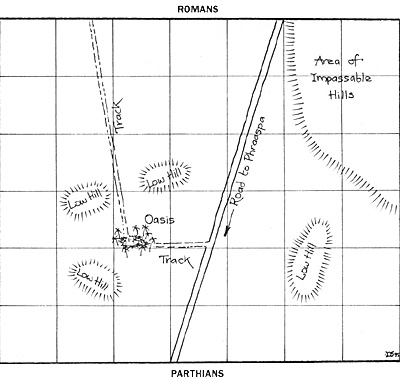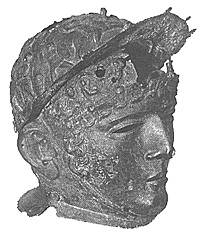
NOTES ON THE OOBS
Firstly, remember that these are purely speculative (and are on a nominal 1:60 scale). Plutarch implies (perhaps) there were 2 legions present, I have gone for one to keep the size of the game down and to allow the introduction of the Armenians. Feel free to change anything. I have been deliberately vague over rating the units due to the wide variety of rules currently in use.
1 The Roman legion has been 'chromed up' for some diversity. The cohorts are rated according to Vegitius (in The Roman Imperial Army by G. Webster). The composition and strength of the 1st cohort is an interesting problem, I subscribe to the theory that it became 'double strength'
TERRAIN NOTES
Impassable - Exactly that, completely impassable!
Low Hills - Melee advantage if on them
Oasis - No movement or combat penalties/ advantages (But see scenario)
Roads and Tracks - Baggage NOT on these will be severely slowed
towards the end of the 1st century AD but have uprated it here for a bit of extra flavour. You may wish to make all cohorts B class and 8 figures. If you use a 1:20 scale consider making the cohorts 16 figures and fielding 5.
2 I am not convinced that the Romans habitually used engines in the field. I have included them here due to the presence of a siege train and to give the Parthians something to 'think about'. In our rules these tend to downgrade the target's morale rather than causing losses.
3 Rate the Spanish and Gallic horse however you see fit. I tend to make the Spanish generally better and with a rather more flexible doctrine. Both are javelin armed.
4 If your rules allow it give the Cretans a fire bonus. I suggest you do not penalise Armenian missile fire for being D class.
5 Polemo was actually the King of Pontus and captured at this battle (later ransomed by the Romans). I have used him as the Armenian C in C as I think it's nice to have a name.
6 Under our rules light cavalry may either skirmish or close for shock combat. Skirmish cavalry may never voluntarily enter shock combat.
7 Consider giving the Parthians a bonus when shooting.
8 Under our rules when a bow unit fires, if it rolls a 1 on its fire dice (a D6) it goes 'ammo low' (javelins on a 1-2, sling never). An 'ammo low' unit which subsequently fires goes 'ammo out' and may not fire again until replenished. For this scenario I ruled that Romans-/Armenians could replenish from the train if the unit had a leader attached (and were in contact with the train), the Parthians could replenish from a pack train element if they were within a 1/2 move and did not fire that turn. Parthian pack animals move as camels. Consider this to be optional.
9The Roman Train consisted of 10 'elements', each element being a model wagon. Feel free to substitute pack animals or markers.
TERRAIN
This is fairly straight forward. Impassable terrain is exactly that. Low hills give a melee bonus if fighting from an upslope position. The Oasis has no effect on movement or combat (you may wish to allow skirmish units to gain some cover benefit).
The road and track are for the benefit of the Roman train (only). On the road it will move 8" a turn, on a track 6" and cross country 4". (NB under our rules a legionary unit moves 8"/turn).
THE HEAT . . . THE HEAT
Every turn the umpire should roll 1D6 and keep a note of the running total. When this reaches 10 1 Roman cohort immediately loses 1 figure unless the Romans have secured the Oasis. The same occurs when the total reaches 15. When the total reaches 20 a Roman cohort or auxilia cavalry unit loses a figure and immediately rolls 1D6. If the score is 1-3 (A class +2, B class +1. -1 if a Roman unit is currently moving uncontrolled towards the Oasis) the unit immediately charges towards the Oasis. It continues to charge each turn until it either reaches the oasis and halts in disorder or contacts an enemy whereupon it fights a melee disordered. Each turn such a unit moves towards the oasis it loses a figure. Once at the Oasis it may rally normally.
 Once 20 has been reached if the Romans do not control the Oasis, for every 5 additional another Roman unit is affected. If the Romans do control the Oasis a 'heat test' is taken for every additional 10.
Once 20 has been reached if the Romans do not control the Oasis, for every 5 additional another Roman unit is affected. If the Romans do control the Oasis a 'heat test' is taken for every additional 10.
E.G. On turn 1 the umpire rolls a 3. He notes it down. On turn 2 a 5 is rolled so the total is 8. Turn 3 a 6 is rolled, the total is now 14. A Roman cohort loses a figure. Turn 4 another 6 is rolled, so a cohort loses a figure (for 15) and another Roman unit loses a figure and must immediately test to see if it makes an uncontrolled move towards the Oasis.
If the Oasis is controlled by Rome, all Roman units within a move of the oasis are immune to the heat.
I suggest you roll randomly to see which unit is affected by the heat. If the Oasis is controlled by Rome units will not go into uncontrolled advance' towrads it, they will merely lose figures.
IMPORTANT - for the purpose of morale tests units in an 'uncontrolled advance' towards the Oasis are counted as routing by their friends and enemies!
You may wish to adjust the above according to the size of your table and how far your troops move. I aimed to have the effects of the heat start 1-2 moves before the Romans could be expected to secure the Oasis.
THE ROMAN TRAIN
An element is considered destroyed if any Parthian unit ends it's move in base to base contact with it. A Parthian unit cannot destroy more than one train element a move. At the end of the game the Parthian player totals how many Roman train elements he has destroyed and adds the score of 1D6. If the total is 8 or more insufficient equipment has reached Antony to continue the siege and the Romans lose. If under 8 the Parthians lose.
Considerations
How this scenario works depends to a certain degree who plays the Armenians. When I ran this scenario I 'cast' a player who likes to hang back and enjoys playing to the spirit of the brief as the Armenians. I also handed out briefs as the players arrived for the evening so the Romans had no real idea that their ally could be working to a set of different objectives (they just assumed his troops were rather poor). I do advise you to try and keep the Romans in the dark about how much support they may get from their allies. It is up to the Parthians how much attention they pay to the Armenians.
Apart from that the scenario should be fairly straight forward.
You should be able to use your normal rules for this scenario, although you may have to make a few changes if using an element rather than figure system (mainly to the heat rules).
I feel that the concept of this game would work well for other theatres/periods. E.g. the Romans in Gaul or Britain or Germany or a British colonial force with some unreliable allies etc.
THE GAME
When I ran this the Romans entered on the track with the Armenians covering their left. The Armenians immediately started to hang back and the Parthians moved the bulk of their forces towards the gap (sending a few skirmish units to 'amuse' the legions). The Romans, with a hanging left flank sent their cavalry (and some anxious looks) towards the (still vacillating) Armenians.
These were engulfed by the massed Parthian horse, 1/2 of which then swung round against the rear of the legion, the other 1/2 driving the Armenians from the field (who by now needed little encouragement). The legion raced for the Oasis and desperately formed hollow square (at one stage with some Parthian horse trapped inside!). The Romans eventually formed a firm square but at the cost of abandoning most of the train. At the end of the game the legion was standing firm around the Oasis and I ruled that they would be relieved, but as they had lost 7 baggage elements it ended in a Parthian (and Armenian) win.
Mark Antony in Parthia 36BC
- Introduction and Background
Roman Briefing and OOB
Parthian Briefing and OOB
Armenian Briefing and OOB
Umpire Notes and Map
Back to Battlefields Vol. 1 Issue 1 Table of Contents
Back to Battlefields List of Issues
Back to Master Magazine List
© Copyright 1995 by Partizan Press.
This article appears in MagWeb.com (Magazine Web) on the Internet World Wide Web.
Other articles from military history and related magazines are available at http://www.magweb.com